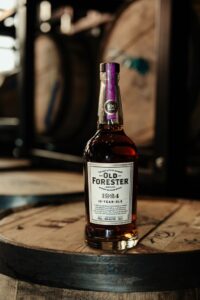By Richard Thomas
Rating: B+
Jack Daniel’s may be the crown jewel of the Brown-Forman empire, but its foundation is Old Forester. Several years ago, the company decided to give that foundation a much-needed brand extension into the premium direction, introducing four new expressions. Each entry in this Whiskey Row series had a year name–1870, 1897, 1910 and 1920–and its own particular twist on Old Forester bourbon. There the Whiskey Row series stopped a few years ago… or so we all believed.
Old Forester launched a fifth installment last month, Old Forester 1924. It’s the first Distillery Row whiskey with an age statement, pegged at 10 years old. It is also a departure from the entire Old Forester line in terms of its stock, being made with a mash bill 79% corn as opposed to 72% corn, with the difference being made up by cutting deeply into the flavoring, secondary rye content rather than the malted barley. That latter grain remains at 10%.
What makes that interesting is that Early Times was made with that mash bill, and Brown-Forman used to own Early Times. Indeed, their distillery in Shively was actually named the Early Times Distillery until the middle of the last decade. Brown-Forman sold Early Times (as well as Canadian Mist) to Sazerac in 2020, and probably transferred most or all of the Early Times stock in inventory as part of that deal. Brown-Forman hasn’t stated any of this, but the dots are all there to connect for those with a good memory.
There is a good reason that deal did not include the stuff currently going into Old Forester 1924, however: it’s bourbon, and Early Times was not. Although it could have been bourbon coming out of distillation, that door was closed the moment the new make was entered into used oak barrels for aging, as bourbon is required by law to be aged in new oak barrels. The main, entry level Early Times expression continues to be labeled as a “Kentucky Whiskey” to reflect this. At some point a decade or more ago, Brown-Forman entered the Early Times new make into new oak barrels, and they’ve still got sufficient stock in the pipeline to introduce what looks to become an annual, limited release.
The Bourbon
The whiskey is bottled at 100 proof, and has a dulled amber look in the glass. The nose leads with deep caramel and butterscotch, accented by cranberries, the trademark banana and just a hint of nuts. On the palate, the liquid flows with a rich texture, a mouthfeel that makes the flavor profile heftier and more luscious than it otherwise might have been. That thick caramel from the nose takes the oaky spice rack by the hand and leads it up onto center stage, leaving the butterscotch current to trail along behind. The cranberry and banana evolves into a more fruit cocktail kind of note, with the sweetness being more syrupy than sugary. The finish turns fully spicy and woody, and lingers on for a fair spell.
The Price
Old Forester 1924 is pegged at $115 a bottle, which is a sticking point. Some will say that is too expensive, and I half-agree with that sentiment, but there is a major caveat with makes that only half-agreement.
Comparing MSRPs in this instance is rather pointless, because while Eagle Rare 10 Year Old or Henry McKenna 10 Year Old have an official price of roughly a third of Old Forester 1924, how often does anyone actually pay the MSRP for these bourbons? But rarely. Everything from Buffalo Trace has been hunted to near extinction. Basil Hayden 10 Year Old and Knob Creek 12 Year Old are generally more available, but they too often see a moderate mark-up on prices.
I’ve argued that liquor companies should start charging prices closer to what the market will bear, if only to discourage hoarding and other distortionate tactics that hurt consumers while yielding little or no benefit to producers. From that point of view, I think whether Old Forester 1924 is actually worth $115 a bottle is debatable rather than obviously too much. Maybe it is $15 too much, but not the $50 over the mark that some bloggers are implying, because their cited baseline exists only on a press release written up in Frankfort.
 The Whiskey Reviewer A World of Whiskey, Poured Every Weekday
The Whiskey Reviewer A World of Whiskey, Poured Every Weekday

